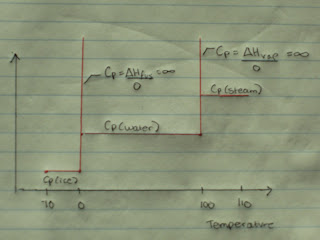Physical Chemistry
Mock Midterm Exam
**disclaimer: I have
no idea exactly what will be on the midterm exam beyond what was listed by the professor in class, although I
do know these section headings are accurate. This mock midterm is written only as
a study tool. It’s usefulness is debatable.
Part I:
Definitions (20%)
Provide definitions for each of the following terms. Do NOT
give any examples of the terms or you will lose marks. (1 mark per definition, -1 mark if
example given)
1) System:
2) Isolated system:
3) closed system:
4) open system:
5) surroundings:
6) Zeroth Law of Thermodynamics:
7) Thermal Energy:
8) Internal Energy:
9) Heat:
10) Work:
11) First Law of Thermodynamics:
12) Reversible Path:
13) Nonreversible Path:
14) State Function:
15) Heat Capacity (also include definition for molar heat
capacity and specific heat capacity):
16) Translational State (strongly doubt this would actually be asked because not defined in lecture):
17) Rotational State:
18) Vibrational State:
19) Equiparition of Energy:
20) Bond Energy
21) Hess’s Law:
22) Heat of Formation of a Molecule:
22) Heat of Combustion of a Molecule:
23) Enthalpy:
26) State:
26) State:
Part II:
Calculations
Provide all work, including appropriate equations, notation,
and manipulation.
Try (or retry) calculations from the textbook without
looking at the solutions manual.
For a good selection of questions do:
Energy, Heat, Work
3, 4, 6, 10
Thermochemistry
15, 17, 21, 24, 29, 32, 34
Equiparitioning of
Energy
1)
Calculate the number of degrees of freedom for
carbon dioxide. Estimate the molar heat capacity of the substance.
2)
Calculate the number of degrees of freedom for
methane. Estimate the molar heat capacity of the substance.
Part III: Short
Answers
1)
What type of system is a coffee cup calorimeter?
What type of system is a bomb calorimeter? Compare and contrast.
2)
If system A is 25ºC and system B is 25ºC, and
system C is in equilibrium with system B, what can we conclude about the
temperature of system C and its relationship with system A?
3)
Draw potential energy diagram of a diatomic
molecule. Label the place of greatest repulsion, A. Label the place of greatest
stability, B. Label zero point, C. Label and show the bond energy. Draw in the
largest state (rotational/vibrational/translational) , and discuss the
placement and magnitude of the other states
(rotational/vibrational/translational).
4)
Is the maximum work done by the system
reversible or irreversible? Explain referring to a P versus V diagram.
5)
Using the definition of enthalpy, show that it
is equal to the heat at constant pressure.
6)
Define both the heat capacity at constant volume
and the heat capacity at constant pressure.
7)
Is work a state function? Explain.
8)
Discuss how differential calorimetry finds the
unknown heat capacity of a substance.
9)
What is the standard enthalpy of formation of
oxygen gas?
10) Why
is the bond energy always positive?
11) Hydrogen gas only has 2 rotational degrees of freedom. Explain
why.
12) Discuss the effects of temperature when comparing calculated
heat capacities using equiparitioning of energy and the actual measured heat
capacity values.
Part IV: True or
False
This section will NOT
be on the exam, however, it may provide a good snapshot as to whether the
definitions are understood.
1)
Heat leaves the system. q is positive. True/False
2)
Energy is stored in chemical bonds. True/false
3)
The system does work. w is negative. True/false
4)
Internal energy does not depend on PV work. True/false
5)
Bond energy is usually greater than thermal
energy. True/false
6)
A diatomic gas has 2 degrees of translational
energy. True/false
7)
PV work is positive for an expansion of a gas. True/false
8)
The lowest vibrational state is at the zero
point. True/false
9)
The heat capacity at a phase change is infinite. True/false
10) Vibrational states are the same as angular momentum. True/false
Part V: Bonus
Questions
1)
Show that PV=nRT is a state function using partial
derivatives and Euler’s Theorem for Exactness without referring to Appendix C.
(Just kidding! Bad joke, I know.) (Yes, I am actually joking about this one, don't try to solve it!)
2)
Describe your experience and opinion of the
textbook with regards to whether you have the e-book or hardcopy, its acquisition
and availability, its use as a study tool, and to what extent it corresponds to
and complements the lectures.


















































